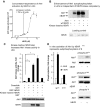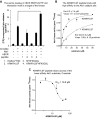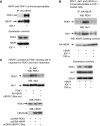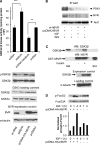Interaction of human biliverdin reductase with Akt/protein kinase B and phosphatidylinositol-dependent kinase 1 regulates glycogen synthase kinase 3 activity: a novel mechanism of Akt activation
- PMID: 27166089
- PMCID: PMC4970609
- DOI: 10.1096/fj.201600330RR
Interaction of human biliverdin reductase with Akt/protein kinase B and phosphatidylinositol-dependent kinase 1 regulates glycogen synthase kinase 3 activity: a novel mechanism of Akt activation
Abstract
Biliverdin reductase A (BVR) and Akt isozymes have overlapping pleiotropic functions in the insulin/PI3K/MAPK pathway. Human BVR (hBVR) also reduces the hemeoxygenase activity product biliverdin to bilirubin and is directly activated by insulin receptor kinase (IRK). Akt isoenzymes (Akt1-3) are downstream of IRK and are activated by phosphatidylinositol-dependent kinase 1 (PDK1) phosphorylating T(308) before S(473) autophosphorylation. Akt (RxRxxSF) and PDK1 (RFxFPxFS) binding motifs are present in hBVR. Phosphorylation of glycogen synthase kinase 3 (GSK3) isoforms α/β by Akts inhibits their activity; nonphosphorylated GSK3β inhibits activation of various genes. We examined the role of hBVR in PDK1/Akt1/GSK3 signaling and Akt1 in hBVR phosphorylation. hBVR activates phosphorylation of Akt1 at S(473) independent of hBVR's kinase competency. hBVR and Akt1 coimmunoprecipitated, and in-cell Förster resonance energy transfer (FRET) and glutathione S-transferase pulldown analyses identified Akt1 pleckstrin homology domain as the interactive domain. hBVR activates phosphorylation of Akt1 at S(473) independent of hBVR's kinase competency. Site-directed mutagenesis, mass spectrometry, and kinetic analyses identified S(230) in hBVR (225)RNRYLSF sequence as the Akt1 target. Underlined amino acids are the essential residues of the signaling motifs. In cells, hBVR-activated Akt1 increased both GSK3α/β and forkhead box of the O class transcription class 3 (FoxO3) phosphorylation and inhibited total GSK3 activity; depletion of hBVR released inhibition and stimulated glucose uptake. Immunoprecipitation analysis showed that PDK1 and hBVR interact through hBVR's PDK1 binding (161)RFGFPAFS motif and formation of the PDK1/hBVR/Akt1 complex. sihBVR blocked complex formation. Findings identify hBVR as a previously unknown coactivator of Akt1 and as a key mediator of Akt1/GSK3 pathway, as well as define a key role for hBVR in Akt1 activation by PDK1.-Miralem, T., Lerner-Marmarosh, N., Gibbs, P. E. M., Jenkins, J. L., Heimiller, C., Maines, M. D. Interaction of human biliverdin reductase with Akt/protein kinase B and phosphatidylinositol-dependent kinase 1 regulates glycogen synthase kinase 3 activity: a novel mechanism of Akt activation.
Keywords: Akt/hBVR/GSK3 axis; activation of hBVR; bilirubin; heme oxygenase 1.
© FASEB.
Figures










Similar articles
-
Formation of ternary complex of human biliverdin reductase-protein kinase Cδ-ERK2 protein is essential for ERK2-mediated activation of Elk1 protein, nuclear factor-κB, and inducible nitric-oxidase synthase (iNOS).J Biol Chem. 2012 Jan 6;287(2):1066-79. doi: 10.1074/jbc.M111.279612. Epub 2011 Nov 7. J Biol Chem. 2012. PMID: 22065579 Free PMC article.
-
The human biliverdin reductase-based peptide fragments and biliverdin regulate protein kinase Cδ activity: the peptides are inhibitors or substrate for the protein kinase C.J Biol Chem. 2012 Jul 13;287(29):24698-712. doi: 10.1074/jbc.M111.326504. Epub 2012 May 14. J Biol Chem. 2012. PMID: 22584576 Free PMC article.
-
Human biliverdin reductase, a previously unknown activator of protein kinase C betaII.J Biol Chem. 2007 Mar 16;282(11):8110-22. doi: 10.1074/jbc.M513427200. Epub 2007 Jan 16. J Biol Chem. 2007. PMID: 17227757
-
Biliverdin reductase: PKC interaction at the cross-talk of MAPK and PI3K signaling pathways.Antioxid Redox Signal. 2007 Dec;9(12):2187-95. doi: 10.1089/ars.2007.1805. Antioxid Redox Signal. 2007. PMID: 17919068 Review.
-
Pleiotropic functions of biliverdin reductase: cellular signaling and generation of cytoprotective and cytotoxic bilirubin.Trends Pharmacol Sci. 2009 Mar;30(3):129-37. doi: 10.1016/j.tips.2008.12.003. Epub 2009 Feb 11. Trends Pharmacol Sci. 2009. PMID: 19217170 Review.
Cited by
-
Biliverdin Reductase A Attenuates Hepatic Steatosis by Inhibition of Glycogen Synthase Kinase (GSK) 3β Phosphorylation of Serine 73 of Peroxisome Proliferator-activated Receptor (PPAR) α.J Biol Chem. 2016 Nov 25;291(48):25179-25191. doi: 10.1074/jbc.M116.731703. Epub 2016 Oct 10. J Biol Chem. 2016. PMID: 27738106 Free PMC article.
-
CRISPR Cas9-mediated deletion of biliverdin reductase A (BVRA) in mouse liver cells induces oxidative stress and lipid accumulation.Arch Biochem Biophys. 2019 Sep 15;672:108072. doi: 10.1016/j.abb.2019.108072. Epub 2019 Aug 15. Arch Biochem Biophys. 2019. PMID: 31422074 Free PMC article.
-
Single-molecule studies reveal regulatory interactions between master kinases PDK1, AKT1, and PKC.Biophys J. 2021 Dec 21;120(24):5657-5673. doi: 10.1016/j.bpj.2021.10.015. Epub 2021 Oct 19. Biophys J. 2021. PMID: 34673053 Free PMC article.
-
Cellular Stress Response (Hormesis) in Response to Bioactive Nutraceuticals with Relevance to Alzheimer Disease.Antioxid Redox Signal. 2023 Mar;38(7-9):643-669. doi: 10.1089/ars.2022.0214. Antioxid Redox Signal. 2023. PMID: 36656673 Free PMC article. Review.
-
Biliverdin Reductase-A Mediates the Beneficial Effects of Intranasal Insulin in Alzheimer Disease.Mol Neurobiol. 2019 Apr;56(4):2922-2943. doi: 10.1007/s12035-018-1231-5. Epub 2018 Aug 2. Mol Neurobiol. 2019. PMID: 30073505
References
-
- Kutty R. K., Maines M. D. (1981) Purification and characterization of biliverdin reductase from rat liver. J. Biol. Chem. 256, 3956–3962 - PubMed
-
- Maines M. D., Trakshel G. M. (1993) Purification and characterization of human biliverdin reductase. Arch. Biochem. Biophys. 300, 320–326 - PubMed
-
- Maines M. D., Trakshel G. M., Kutty R. K. (1986) Characterization of two constitutive forms of rat liver microsomal heme oxygenase. Only one molecular species of the enzyme is inducible. J. Biol. Chem. 261, 411–419 - PubMed
-
- Stocker R., Yamamoto Y., McDonagh A. F., Glazer A. N., Ames B. N. (1987) Bilirubin is an antioxidant of possible physiological importance. Science 235, 1043–1046 - PubMed
Publication types
MeSH terms
Substances
Grants and funding
LinkOut - more resources
Full Text Sources
Other Literature Sources
Research Materials
Miscellaneous

